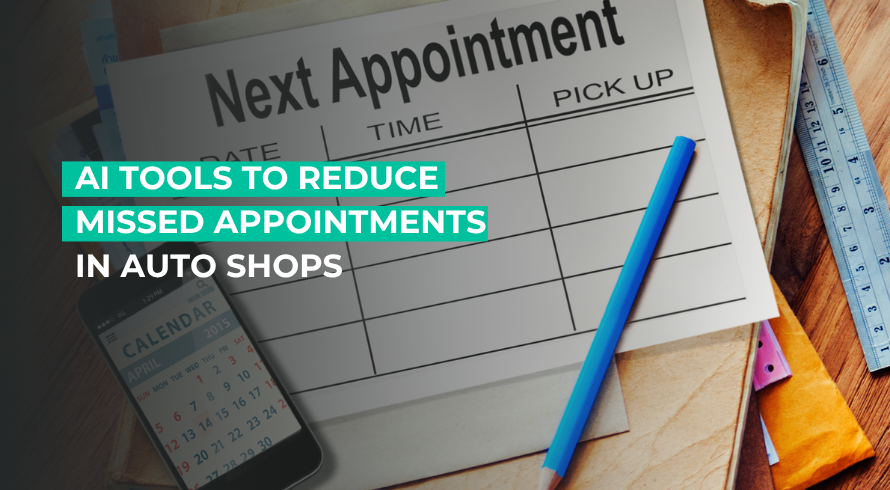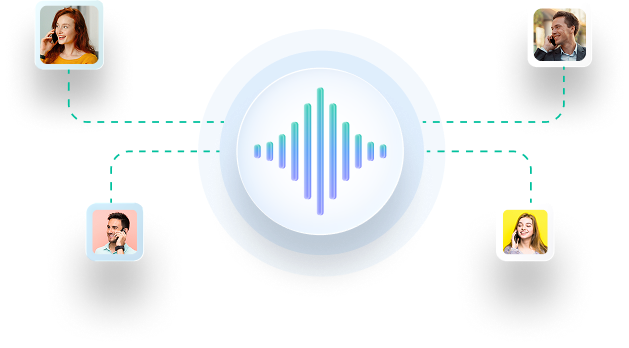Every minute is crucial for a thriving auto repair business. But despite all their efforts, shops often lose out on revenue from missed customer calls or when customers fail to show up for scheduled appointments.
Every customer lost leads to wasted technician hours, empty service bays, and another day of low business opportunities. All of this may seem insignificant in hindsight, but when you look at numbers, shop performance doesn’t look too good.
Why do no-shows and missed calls persist in auto repair businesses
Walk-in customers come and go throughout the day. Whether they’re here for a tire change, oil filter replacement, or a simple maintenance check, it takes one to two technicians and other resources to complete the job. And if the shop has customers all day, then things get chaotic pretty quickly, and it gets harder to handle incoming calls, walk-ins, and send out service reminders.
Let’s look at the reasons a little closely.
1. The front desk is overloaded
Auto shops run on an on-the-go basis. Especially in the case of startups and smaller shops, there’s usually a small team that handles everything from administrative work, customer handling, and even marketing.
This means things can fall through the cracks during peak hours. The front desk has lots of visiting customers waiting for their cars to be checked. Then the office phone is ringing continuously, waiting to be answered.
To keep up the pressure, the available technicians and staff are putting in their maximum effort. Getting the repairs done and delivered before their deadlines is their primary focus, so naturally, they miss out on admin tasks like answering the phone or sending an appointment reminder. The result? You lost out on a repeat customer because they missed their appointment.
2. The customer forgot about their appointment
A no-show is when the shop has booked an appointment for the customer, but the customer doesn’t show up on the day. They might have forgotten about the appointment date or had an urgent errand on the same day. This can also be due to no reminders or confirmation messages from the shop to remind customers about their bookings.
3. Limited staff and overbookings
This is a common problem faced by most shops. On busier days, when the majority of the staff are occupied it gets quite challenging to handle customers, take calls, schedule appointments, and send out reminders on time. Even when staff take calls, they may just have enough time to answer a few general queries and promise to get back to customers with detailed service information.
Sometimes, this leads to the shop being overbooked and puts an extra load on unprepared and exhausted staff. And after a long day of work, after-hours follow-ups can get missed, which gives the impression of poor customer experience, and the potential business goes to your competitor.
4. Double-booking errors
Double-bookings and scheduling errors are a byproduct of manual appointment scheduling and too much reliance on spreadsheets for collecting vehicle service history.
What normally happens is that a customer comes in for their booked services and sees the bays are already occupied. They get frustrated over the lack of professionalism and leave with a bad impression of your shop.
How do scheduling problems impact auto shops?
1 missed call may seem like no big deal. But when this number increases by the day, it starts to show as losses in your accounting. The impact of this is seen in many aspects of your shop operations:
Unhappy customers
When appointments are missed or when a customer finds their promised slot occupied by another customer, they’re bound to feel frustrated and will likely not return.
Idle service bays
A booked appointment means that the service bay is reserved during those hours. Technicians make sure all service equipment and tools are ready. When the customer doesn’t show up, the bay remains idle, the cost and time spent on tools are wasted, and technicians’ skills are not utilized. This increases costs and expenses.
Time wasted ordering parts
Oftentimes, special parts and materials are ordered in advance for larger vehicle repairs, and if the customer is a no-show, then those parts go unused. This also adds extra time for staff to revisit inventory and take a count of their stocks.
How AI can solve scheduling challenges
Shops that are stuck with pen and paper schedules are losing out more than just new business opportunities. More and more growing businesses are switching to automation to help streamline repetitive tasks like booking appointments, handling customer calls, and more.
This is where AI is changing the game. AI tools can help auto shops reduce scheduling problems and make the process a lot more efficient. From not missing calls and accurately scheduling appointments to ensuring customer satisfaction.
Here’s what AI can do for you:
24/7 call answering
AI tools can take up customers’ calls at any time. This means no calls are ever missed.
Automate bookings
These tools can book appointments and enter correct customer details, time, and date. This way there are no double bookings or other human errors.
Multilingual communication
Most AI phone agents have multilingual language settings to better suit customer needs. AI can adjust tone, voice, or text to offer a better customer experience.
Smart reminders
AI sends customers automated appointment reminders a day before it’s due. To reduce no-shows, customers receive a confirmation message, which they reply to with a yes or no. If they need to reschedule, the AI can book a new timeslot for them based on their availability.
Benefits of implementing AI for auto repair shops
1. Reducing Scheduling Errors
Auto shops that follow an inconsistent and decentralized approach to booking appointments normally encounter scheduling conflicts. Busy technicians may have a verbal communication with the customer about a booking which they forgot to record in the system. Another staff member books an appointment, notes it down on the spreadsheet, but enters the wrong date.
AI scheduling tools, such as AI receptionists, can handle bookings in real-time. They capture important details like dates, times, and requested services. They block the calendar with booking information. Since the tool knows your calendar, other customers are automatically only given open slots to avoid any double-bookings.
Managers can also add or update AI about the buffer time. This is the time in between appointments that technicians require to clean bays, take some rest, and prepare tools for the next appointment.
2. Making appointment booking easier
The point of going digital is to offer maximum convenience to customers. And if you have a functioning website for your shop, why not use it to offer the convenience to book appointments without having to call the front desk?This gives customers multiple channels for easier communication and appointment bookings.
Customers find it more convenient to book appointments online. They don’t want to go through the hassle of making a call and waiting. This is why AI tools can now be integrated not only on phones but also in text, online chats, and support on websites.
Customers can send a message on your website at any time, and the AI chatbot can respond in real time within seconds. Customer queries are resolved almost immediately or raised to the concerned team member, appointments are booked faster, and customer experience is made a priority.
AI tools can also send promotional or feedback texts after service. Promotional texts are a way to make customers recall your auto shop business and keep coming back. After they have gotten their cars serviced, the tool sends a feedback form to customers for their thoughts on the service. All constructive feedback is stored and analyzed, and reports can be viewed by shop owners to improve their service quality.
Free Shop Handbook eBook
Discover the essential steps to create a compliant and effective Shop Handbook with our comprehensive eBook.
3. Automated Phone Call Handling
It’s a busy hour at the auto repair shop. Service bays are booked with, technicians and workers fully engaged in repairs and other services. The manager is busy dealing with walk-in customers, waitlists, and payments collection. Throughout this, the phone in the shop continues to ring. But no one is available to attend the calls.
AI phone systems can handle a high volume of calls during peak hours. The technology is built so that AI can talk to hundreds or thousands of customers at once. Customers never find the phone busy or have to stay on hold waiting for their turn. This means no missed calls and happier customers.
AI also ensures that each customer call is handled well. A customer calls, the AI will listen to what they say and convert it into text. Then another system works on what the customer wants.
The tool’s database stores not only all information about the business from shop hours to pricing and service details, but it also keeps a record of all customer information which it can easily pull up if it’s a repeat customer. General customer queries are immediately answered. AI communicates in a natural voice and even detects the customer’s mood through their voice. In response, AI greets and talks to customers in a way that makes customers feel understood. For complex and technical repair queries, AI makes sure the call is taken up by a manager or technician available.
The AI phone system saves time for other staff to focus on in-shop customers and repair services. They don’t even have to worry about call-backs after hours. A customer with a vehicle breakdown calls late at night. AI can quickly take up the call and book their appointment for the next day.
4. Smart reminders and predictions
AI tools are not only good at receiving calls and bookings. They go beyond and ensure there are fewer no-shows. After booking an appointment, the AI receptionist sends timely reminders to the customer to reduce no-shows.
A day before the appointment, the tool sends a two-way confirmation message to the customer, asking them to reply with a “yes” or “no”. If the customer responds yes, the appointment gets confirmed. This saves time for staff who previously made manual calls to confirm appointments.
What about customers who reply no or don’t respond to confirmation messages? The AI scheduling tool uses predictive analysis to predict how likely they are to be a no-show. For instance, an AI receptionist integrated with the shop’s existing shop management system can look into customers’ service history and predict the likelihood of them being a no-show.
AI also looks into factors such as service history, car model, frequency of repairs, and their type to predict reliability patterns. AI also analyzes how and when the appointment was booked. An appointment booked online is at a higher risk of no-show than those booked via call. Also, an appointment date set to be two months later is more likely to be forgotten by the customer.
In such cases, the tool increases the number of reminders when it’s closer to the scheduled date with options to cancel or reschedule, if needed. This ensures bays are unoccupied for other customers and technicians stay productive.
Evaluate AI tools as per your repair shop needs
What AI tool does your business need? This depends on how you want AI to interact with your customers. Some auto shops would like to greet their customer in a specific way. Some want a professional and natural tone to represent their business.
Other shops may select tools based on their operational needs. For instance, shops facing a lot of no-shows and missed calls may need an AI phone system. While another business needs help with everything as a whole, from answering customer calls to taking appointments. systems. There’s a tool for every business and their specific needs.
Here’s a list of AI tools you can consider for your auto repair business:
AI Receptionists & Voice Agents
AI receptionists and voice agents are tools that can take calls for your shop while you’re away or closed for the day. This makes it easy for businesses to schedule appointments and handle customer inquiries round the clock and deliver an excellent customer experience.
A great example of such a solution is AutoLeap AIR, the first-ever AI receptionist for auto shops. Its features include handling calls 24/7, multi-language support, booking and rescheduling appointments, answering general customer queries, and providing detailed call reports.
Automated Reminder Systems
Sends timely reminders and confirmation about appointments to the customers. It can be done through text, phone, or email. Most of the conversations are automated and two-way so that customers can reply.
Predictive Attendance Analytics
These AI tools can predict a customer’s history of missing appointments. If they have missed more appointments in the past, the tool will flag them as high risk for no-show. As per predictions, the next steps are targeted reminders, deposit prompts, last-minute cancellations, or reschedule options.
Dynamic Waitlist and Backfill Management
AI tools can maintain customer waitlists in real time. When there are last-minute cancellations, AI can pick a customer from the waitlist to fill the spot. This way no service bays and technicians are underutilized.
Step-by-step roll out for your shop
You do not have to be intimidated by launching AI in your shop. Having a clear roadmap, you can decrease the number of missed calls, remove no-shows, and increase the efficiency in a matter of a few weeks. This is a step-by-step plan using some of the proven strategies and actual industry results.
Set your baseline metrics
Before making any changes, start by monitoring your current no-show rate and the number of calls you miss. Setting a baseline provides a clear point of reference for where improvement will be achieved after automation and the AI tool is installed.
Identify quick wins
You can start small and gradually increase the level of automation based on your business needs. For instance, introducing an AI receptionist can address after-hours calls and enable two-way reminders to minimize no-shows. This means your front desk has more time to focus on other important and profit-driving tasks.
Connect your tools
Before you bring on any new system into your existing workflows, ensure that your AI solution can be integrated with your current shop management software (if you use any) and calendar. These will ensure that the customer data, service history, booking details, and follow-ups are all synced up with the tool.
Train Your Team
New tools can only achieve results when your team knows how to use them. Set up onboarding calls with the team to train the staff on how to check messages, view leads that are recorded by the tool, and access appointment data.
Measure and improve
You can only know the impact of a new tool if you’re measuring the right metrics since day one. Be sure to regularly check on important metrics every day in the initial phases to ensure everything is working, then space it out to every week, and so on.
If you don’t see improvement in your no-show rates or missed calls, try adjusting the reminder timing or sequence of calls. Regular check and minor adjustments, supported by your starting point, can transform a minor improvement into continued growth.
Wrapping up
Whether it’s an AI phone system, a receptionist, or a smart reminders system, all these tools bring their own set of benefits to help shops unlock growth.
Gone are the days of recording appointments on paper and sticky notes. With AI, technicians and staff can focus on what they do best—vehicle repairs—while the tool handles all the repetitive work. If you’re considering automation or interested in any tools, take this post as the sign you needed to step into the world of AI.
FAQs
How do you reduce no-show appointments in an auto shop?
Shops can reduce no-shows by sending out reminders, confirming appointments in advance, and offering online scheduling options.
What are the most suitable AI tools in an auto repair shop?
It depends on their specific auto repair business needs. They can use AI phone systems, AI receptionists, and smart reminder systems to reduce missed calls and manage appointments.
How can AI help with missed calls?
AI can take over the front desk by answering customer calls 24/7, after business hours, on weekends, and holidays.








